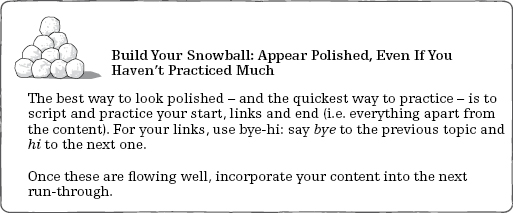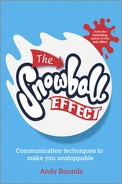41
When you want to appear polished, even if you haven’t practised much
You often have two conflicting issues when presenting:
- You want to look polished and impressive.
- This takes time to achieve, and you haven’t got much of it.
This chapter addresses both. In fact, my customers frequently tell me this chapter’s technique – called “bye-hi” – has the highest value:time ratio, in that it:
Bye-hi works when you’re presenting either as part of a team or on your own. I’ll start with the former, then show how to apply it to the latter.
Polished presenting (when you’re in a team)
A relay race is often won or lost at the baton change. After all, runners are great at running. It’s the handover where problems can arise.
Similarly, presenting teams often come unstuck at the “speaker change”. After all, presenters are great at presenting. It’s the handover where problems can arise.
So, just as relay teams repeatedly practice their baton changes, so too must your team practice your handovers.
This is where you use bye-hi: at the end of her slot, Presenter One says “bye” to her subject (because it’s finished) and “hi” to Presenter Two’s (because it’s starting):
“So (bye) I’ve shown how this project will help our workforce. But (hi) the financials have to stack up too, something that Jane will now run through with you.”
A bye-hi will help your audience know that the topic is changing. They also seamlessly introduce the next presenter, who can crack on with her topic rather than introducing it herself.
Polished presenting (when you’re on your own)
Similarly, when you’re presenting on your own, use bye-hi to link your topics, slides and messages. This means that the quickest and best way for you to practise is:

In other words, script, fine-tune and practice your:
Once your start, links and end are flowing well, do a run-through – quickly at first, to check the flow; then more detailed.
Let’s finish with another bye-hi:
So, that’s covered the detail behind how to practice quickly. Let’s now look at a quick summary of the key points . . .

